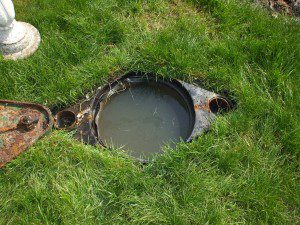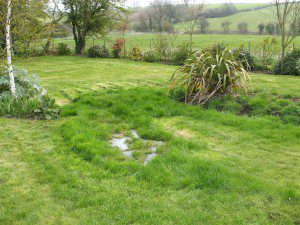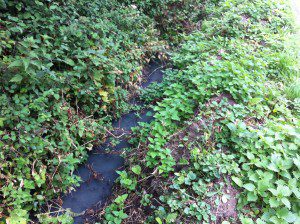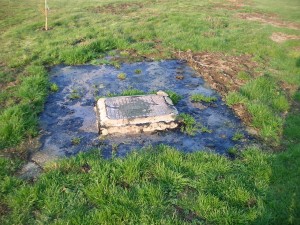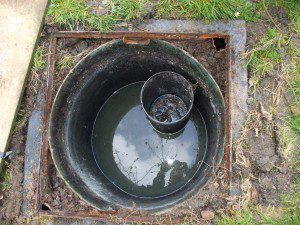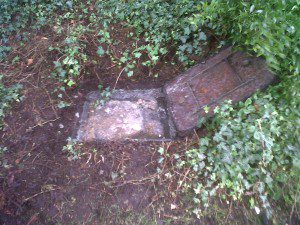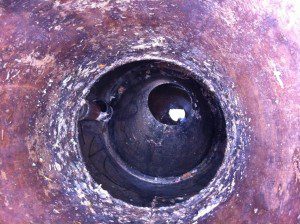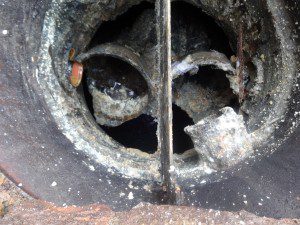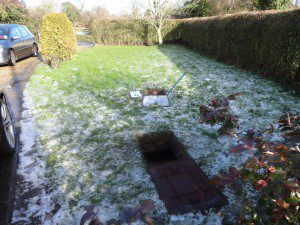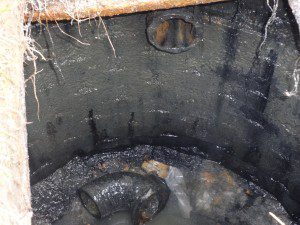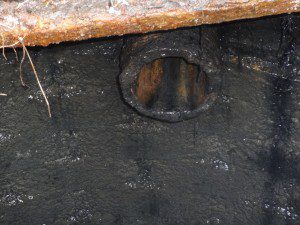Septic Tank Failure
Septic tank failures can be the cause of various issues for homeowners with some of the most common failures being associated with odour nuisance and pollution in watercourses. However, the most common septic tank failure we come across is where the existing septic tank is flooding due to the receiving soakaway failing.
Septic tanks can be in the form of a traditionally built tank from either brick or concrete, or in the form of a prefabricated tank. Problems can be experienced with all types of septic tank, and all septic tanks are designed to promote the growth of anaerobic micro-organisms which partially degrade the receiving waste water.
Did you know that the cost to resolve your septic tank failure may be covered by your existing buildings insurance policy?
Mantair works in partnership with the UK’s leading drainage insurance claims management company to offer our customers a unique insurance claims management service. Providing expertise in managing insurance claims for the costs of repairing or replacing damaged drainage systems, we work on behalf of property owners helping them to save thousands of pounds in resolving their septic tank problems. Read more…
Common Septic Tank Failures Explained
The process within a septic tank is called ‘anaerobic digestion’ which reduces the sludge volume. During the digestion process methane, hydrogen sulphide and other gases are produced and these gases can in some cases cause a serious odour nuisance.
Septic tanks should be correctly vented to allow the noxious gases to escape to the atmosphere.
Can my septic tank discharge to a ditch, stream or river?
The effluent from a septic tank is disposed of to a drainage field / soakaway. Under no circumstances should it be allowed to discharge to a ditch, stream or river. Such a discharge is an offence under the Public Health and Water Resources Acts and renders the offender liable to prosecution by the Statutory Authorities. Read more….
My septic tank is flooding?
There are many reasons which may cause a septic tank to flood and these can range from something as a simple as an outlet ‘dip pipe’ being blocked to more serious problems involving the receiving soakaway system.
The effluent level inside a septic tank should be at the level of the outlet pipe. In some instances either the inlet or outlet pipes for a septic tank can become blocked with materials such as fat or tissue. If the inlet ‘dip pipe’ becomes blocked this would result in the foul drainage to the tank flooding, and this is more common in older traditionally built septic tanks. If the outlet ‘dip pipe’ becomes blocked this would result in both the septic tank and incoming foul drainage pipe work flooding. In some cases it is only necessary to clear the blockage with drainage rods.
The most common cause for a septic tank flooding is due to the receiving soakaway and not the septic tank. If a soakaway fails and prevents the effluent from percolating through the ground this will result in the soakaway, septic tank and the foul drainage pipe work surcharging. Septic tank soakaways can fail for a number of reasons and these include:
Ground Conditions
The soakaway being constructed in ground conditions which are non-permeable such as sandy clay, silt clay and clay. This would result in the effluent that discharges to the soakaway filling the soakaway and subsequent flooding of the septic tank, or potentially effluent bursting out of the ground causing a health hazard.
It is important that the percolation characteristics of the ground are suitable in both summer and winter months. To identify whether the ground conditions are suitable for a drainage field / soakaway and to determine the size required it is necessary to conduct a Percolation Test. Without the results of a Percolation Test there is no way of knowing the size of drainage field / soakaway required or if this disposal method would indeed work.
Natural Water Table
The drainage field / soakaway being under the natural water table. This can often be the cause for septic tank soakaway systems failing during winter months only. When a drainage field / soakaway is operating underneath the natural water table the septic tank, soakaway and foul drainage pipework will be at the same level as the surrounding water table and as a result the flooding within the system can be moderate or severe.
Problems with septic tank systems operating in high water table areas can be overcome by installing a Mantair septic tank conversion system.
Root Ingress
The drainage field / soakaway being constructed in close proximity to trees and shrubs. Roots of trees and shrubs planted too close to a drainage field / soakaway can enter the drainage pipe work and block the pipes. Root ingress into drainage fields / soakaways is the cause of many systems blocking and as a result flooding of the septic tank system. Mantair offers a unique insurance claims management service to our customers for situations where root ingress has damaged a drainage system.
Physical Damage
Physical damage to the drainage field / soakaway. In some cases a septic tank can flood due to the receiving soakaway pipe work becoming damaged and broken. This can often be due to heavy machinery moving over the soakaway and crushing the pipes. Older ‘but-jointing’ soakaway systems were constructed using clay wear pipes and it is common for these clay wear pipes to become dislodged due to ground movement, resulting in soil entering the pipe work and blocking the soakaway.
Increase in Flow
Additional waste water entering the septic tank. A septic tank and the receiving drainage field / soakaway are designed to cater for a certain volume of flow per day. If the flow being discharged to a septic tank increases and the tank is not designed for this additional flow then problems can be experienced with both the septic tank and drainage field / soakaway system.
Sodium Binding
Excessive use of detergent based products i.e. dishwasher tablets, washing powders etc. will lead to eventual failure of the soakaway. This is caused by a process called sodium binding where the sodium present in detergents cause any silt or clay particles in the sub soil to bind together to form am impervious layer. The same effect occurs if a water softener is present as the softened water will have relatively high sodium content.
Age of the Soakaway
Older drainage fields / soakaways can fail due to a build-up of sludge solids. The level of sludge solids passing through the septic tank are due to a number of reasons, including size of the tank, nature of the waste water and emptying frequency.
Septic tank failure
There are various reasons why septic tanks fail and some of the most common causes are as follows:
Septic tank baffled collapsed
Within most prefabricated septic tanks are internal baffles or cones which are designed to prevent solids and floating material from passing through the tank. In some instances baffles and cones can collapse resulting in solids and floating material passing through the tank and into the soakaway network.
Prefabricated tanks can also implode if there is substantial ground movement around the tank or if the tank hasn’t been installed using the correct back-fill material. If these tanks are not back-filled with concrete this can result in flotation of the tank especially when a tank is emptied during wet weather periods.
Mantair offers a unique insurance claims management service to our customers for situations where an existing septic tank baffle has collapse or where the tank has imploded or split.
Traditionally Built Tanks
One of the most common failures on traditionally built septic tanks is when the dip pipes fall away from the inlet or outlet pipes. This can sometimes occur when the septic tank is emptied.
Concrete septic tanks can crack and leak allowing ground water ingress. If ground or surface water enters a tank this can result in flooding and failure of the soakaway. Excessive water ingress into a septic tank would result in sludge solids passing through the tank and into the soakaway, resulting in failure of the soakaway.
Mantair are able to identify whether the damage to your septic tank might be covered by your insurance policy.
Potential problems for Septic Tanks
Excessive draining of cooking oils and grease can cause the inlet drains to block. Oils and grease are difficult to degrade and can cause difficulties with the emptying. Disposing of non-biodegradable items such as nappies and baby wipes will rapidly clog the septic tank and these items should not be discharged to the tank at any point. Certain chemicals should not be discharged to septic tanks, including pesticides, herbicides, paint, solvents or high levels of bleach.
Septic tank failure signs
- Drain or sewage backup;
- Discharge of effluent to surface or watercourse;
- Effluent level above the septic tank inlet;
- Septic tank being emptied frequently;
- Depression area over the septic tank or soakaway.
Septic tank solutions
As detailed throughout this page, there are various reasons for septic tank problems. The solution will depend on a number of factors and it is advisable that professional advice is sought prior to any remedial works taking place.
Can my Septic tank be upgraded or converted?
The majority of septic tank problems in the UK can be overcome by installing a Mantair septic tank conversion unit. The Mantair unit is specifically designed to be installed within an existing septic tank or cesspool, converting the existing tank into a sewage treatment plant.
The Environment Agency recognises the Mantair unit as a sewage treatment system and provides Permit Certificates approving the discharge from these systems direct to ditches and streams, thus removing the need for a soakaway network. All Mantair units are designed to ensure that the completed installation complies with the requirements of the Environment Agency and Building Regulations.
Contact Us
For further assistance and advice, contact us on 01255 853890 | enquiries@mantair.com – or by filling out the form on our contact us page.
